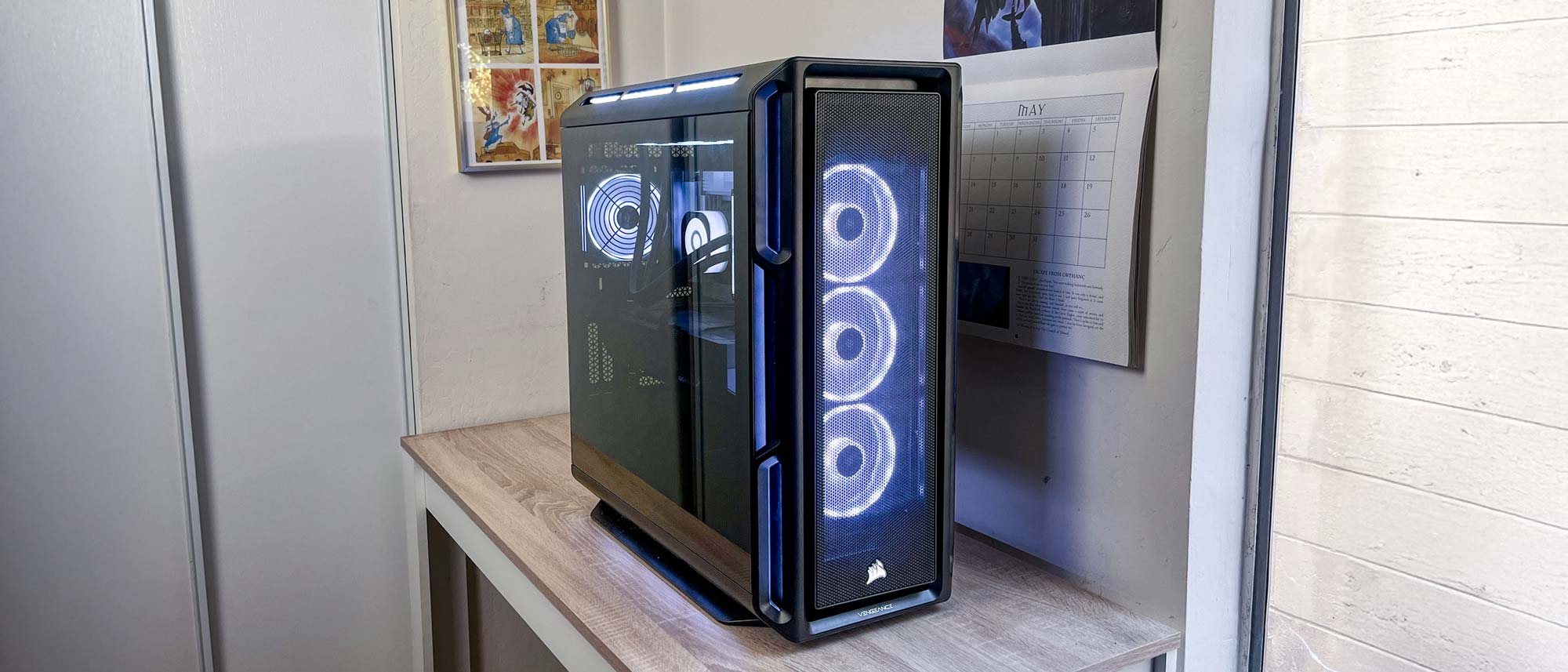Tom's Guide Verdict
The Corsair Vengeance i8300 delivers awesome gaming performance with an equally awe-inspiring price tag. If you can afford this $7,000+ gaming PC you can count on best-in-class 4K gaming performance with almost no fan noise, but our in-depth testing reveals this isn't the best deal when it comes to 4K PC gaming.
Pros
- +
Top-tier 4K gaming performance
- +
Stays quiet under pressure
- +
Easy-to-access case
- +
Love that RGB lighting design
Cons
- -
Prohibitively high price tag
- -
Heavy and difficult to move
- -
Outperformed by cheaper gaming PCs in some games
Why you can trust Tom's Guide
I've spent the last two weeks testing the new Corsair Vengeance i8300 ($7,399) gaming PC, and the experience has redefined how I approach playing games.
Corsair sells Vengeance gaming PCs in a variety of configurations and prices, but the company sent us its most expensive model for review — and you can feel the luxury you're paying for in how reliably every game I tested on this machine booted up quickly and ran like a dream, with almost zero noticeable fan noise from the case.
The case itself is so heavy, however, that I didn't trust any of my desks with it and instead kept it on the floor next to my 4K TV. But since it makes so little noise the Vengeance i8300 actually turns out to be a great gaming PC for the living room, and it's opened my eyes to a new dream: 4K PC gaming on the big screen, from the comfort of my couch.
If you can handle the weight and you're willing to pay the eye-watering price, I think the Corsair Vengeance i8300 is easily one of the best gaming PCs I've ever tested. Here's why.
Corsair Vengeance i8300 (2025) review: Cheat sheet
- What is it? The top-of-the-line Corsair Vengeance gaming PC for 2025, packing the latest AMD/Intel CPUs and the best-in-class Nvidia GeForce RTX 5090.
- What does it cost? The high-end Corsair Vengeance i8300 I review here can be purchased from Corsair for $7,399 with your choice of Intel or AMD chips, though at time of publication Corsair is discounting the AMD model down to $6,599.
- Who is it for? PC gaming enthusiasts who want to pay top dollar for a big, quiet gaming machine that's great for 4K gaming and one of the very best gaming PCs you can buy in 2025.
- What do we like? I love how this Corsair Vengeance i8300 review unit can run any PC game I want to play in buttery-smooth 60+ FPS at 4K with all graphical settings cranked to max.
- What don’t we like? Obviously, the price of this beast is a tough pill to swallow. I'd have to spend months if not years saving to afford PC gaming like this, and that's a real barrier to entry. I also don't love how heavy it is, as I wouldn't trust the Corsair Vengeance i8300 on a flimsy desk.
Corsair Vengeance i8300 (2025) review: Specs
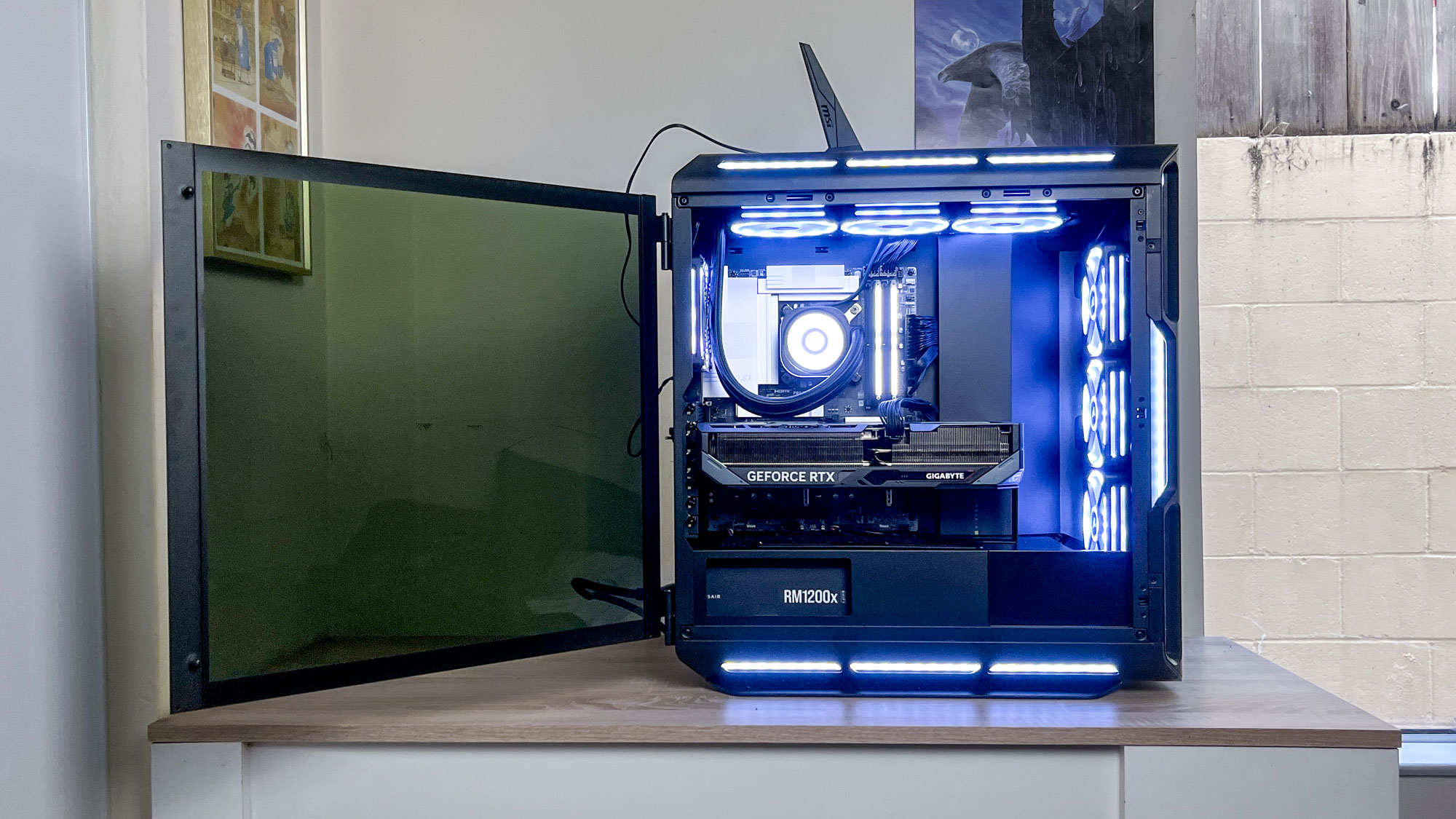
| Header Cell - Column 0 | Corsair Vengeance i8300 (2025) |
|---|---|
Price | $7,399 |
CPU | Intel Core Ultra 9 285K |
GPU | Nvidia GeForce RTX 5090 |
RAM | 64GB DDR5 |
Storage | 2TB SSD + 4TB SSD |
Ports (front) | 4x USB 3.0 Type-A, 1x USB 3.1 Type-C, headphone/mic jack |
Ports (rear) | 4x USB 2.0 Type-A, 2x USB 5Gbps Type-A, 1x USB 10Gbps Type-A, 1x USB-C 10Gbps |
Size | 25.6 x 24.3 x 13.8 inches |
Weight | ~32 pounds |
Corsair Vengeance i8300 (2025) review: The ups
I've really enjoyed my time gaming on the Corsair Vengeance i8300, and there are a few key strengths I want to highlight so you know what you're buying.
Top-tier 4K gaming with almost no fan noise

As I mentioned earlier, I decided to leave our Corsair Vengeance i8300 review unit on the floor next to my LG C2 OLED TV for the majority of the review period because I just didn't trust my flimsy sit/stand desk with this 30-pound beast.
But that was only part of the reason I kept the Vengeance in the living room — the rest of it was that I wanted to see how the best PC games look running at max settings on a 65-inch 4K OLED display, and I had a hunch this $7,400 gaming PC could handle it.
Get instant access to breaking news, the hottest reviews, great deals and helpful tips.
Sure enough, I was blown away by the experience of PC gaming on the couch with the power of an RTX 5090, a top-tier Intel Core Ultra 9 CPU and 64GB of RAM at my beck and call. Games like Alan Wake 2, Cyberpunk 2077, Star Wars Outlaws and Red Dead Redemption 2 ran beautifully, though I had to enable Nvidia's DLSS tech where possible to iron out occasional stutters that caused the framerate to dip below 60 FPS.
The results from our testing lab back up my anecdotal experience, as the Corsair Vengeance i8300 performed better in our tests than any gaming PC I've reviewed to date.
| Row 0 - Cell 0 | Alienware Area 51 | Corsair Vengeance i8300 | Corsair Vengeance a7500 |
Assassin's Creed Shadows (Ultra High) | 76 | 64 | 40 |
Black Myth Wukong (Cinematic) | 59 | 60 | 32 |
Cyberpunk 2077 | 56.7 | 57.5 | 29.2 |
Red Dead Redemption 2 (Ultra) | 84.6 | 64.4 | 36.6 |
To show you what I mean, I've charted some key gaming benchmarks above against a cheaper Corsair Vengeance a7500 (AMD Ryzen 7 9800X3D, Nvidia GeForce RTX 5070 Ti, 32GB RAM, ~$3,399) and our current pick for best premium gaming PC, the Alienware Area 51 (Intel Core Ultra 9 285K, Nvidia GeForce RTX 5090, 64GB of RAM, $5,699).
As you can see, the Corsair Vengeance delivers nearly flawless 60+ FPS performance in some of the latest and most demanding PC games. This is raw performance too, without any upscaling tech like Nvidia DLSS or AMD FSR enabled. When I enabled DLSS on games like Cyberpunk, I was able to enjoy full path-traced lighting and incredible visual effects while framerates hovered consistently in the 70-90 FPS range.
But you can also see that despite our Corsair Vengeance i8300 review unit costing thousands of dollars more than our Alienware Area 51 review unit, the Alienware PC actually delivers better performance in some games. And where the Corsair does outperform the Alienware, it's only by a matter of a few extra frames per second, which makes the nearly $2k price difference between the two hard to swallow.
However, the Corsair performed better than the competition across the board in our general performance tests.
| Row 0 - Cell 0 | Alienware Area 51 | Corsair Vengeance i8300 | Corsair Vengeance a7500 |
Geekbench 6 single-core | 3148 | 3303 | 40 |
Geekbench 6 multi-core | 21786 | 23328 | 32 |
SSD speed test | 1898.2 | 2480.5 | 2659.9 |
Video editing test (mm:ss) | 1:53 | 1:47 | 3:02 |
As you can see from the chart of results above, the Corsair Vengeance i8300 outperformed the competition in both the single-core and multi-core Geekbench 6 CPU benchmarking tests, despite the fact that the Alienware Aurora has the same Intel Core Ultra 9 285K CPU.
The Vengeance i8300 also burned through our custom video editing test (which times how long the PC takes to transcode a 4K video down to 1080p using Handbrake) faster than the rest, though the far cheaper Corsair Vengeance a7500 actually had a faster SSD than the more expensive i8300 I'm reviewing here.
So whether you're gaming, editing video or doing other computationally-intensive tasks, you can count on the Corsair Vengeance i8300 delivering best-in-class performance. However, our testing reveals that you aren't actually getting much better gaming performance than our current pick for best premium gaming PC, the cheaper Alienware Area 51.
Stays quiet under pressure
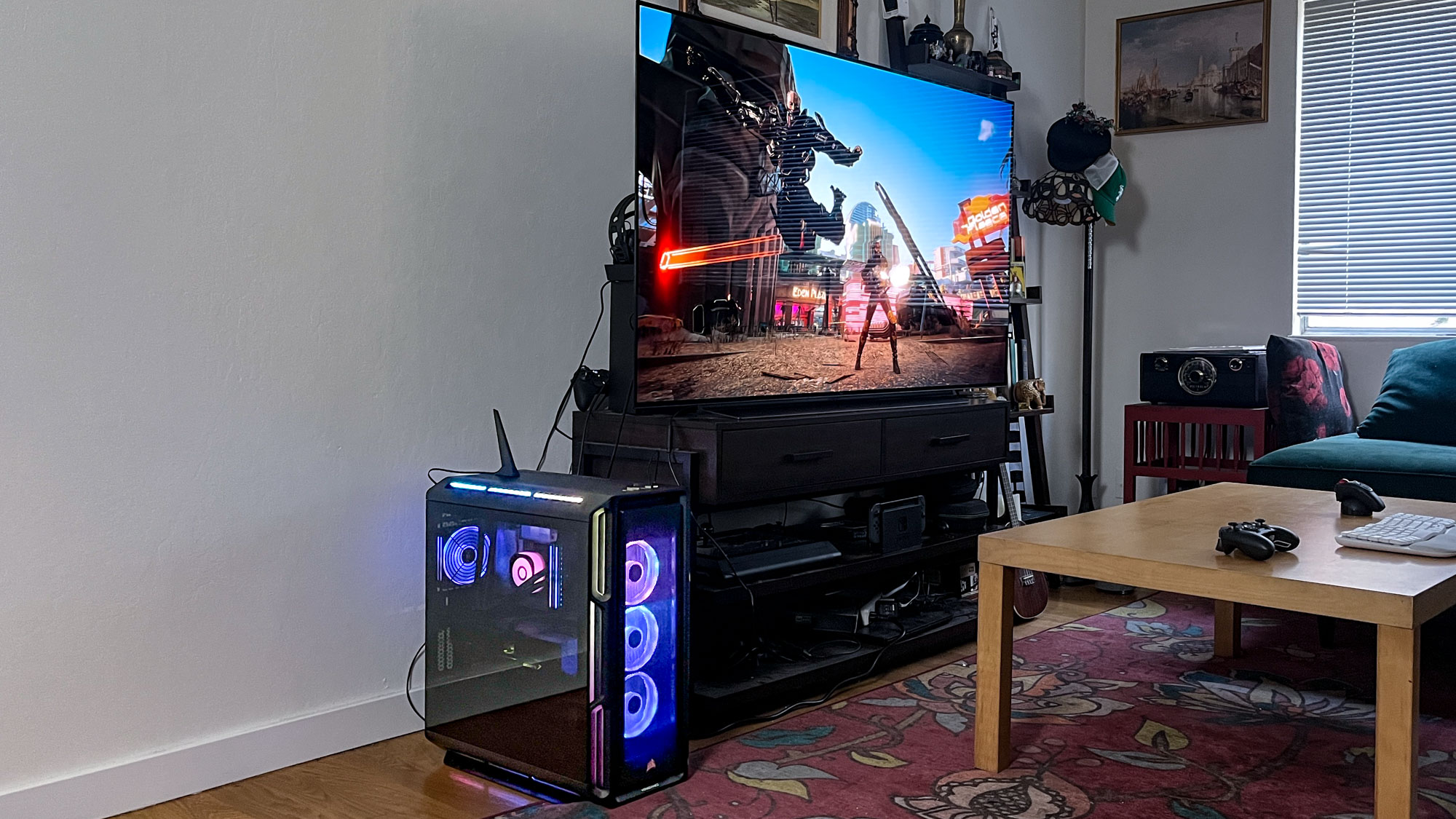
Since I was PC gaming in the living room without headphones it was key that the PC not make too much noise, so I was paying close attention to how loud the Corsair Vengeance i8300 got during intense gaming sessions.
After two weeks of testing I'm pleased to report that even after hours of playing Cyberpunk 2077 or Doom with all settings cranked to max, the PC's fans never made more than a low hum.
So while there definitely is some fan noise, especially when sustaining peak performance, it's quiet enough that you barely notice the sound from 8 feet away.
Easy-to-access case design

While I don't expect you would need to upgrade this machine for years to come, I appreciate that our Corsair Vengeance i8300 review unit has an easy-to-access case that's roomy and well-organized inside.
To get in you just have to pull the see-through glass panel on one side of the Corsair iCUE 5000T RGB case open, no screwdriver required. You can also pretty easily remove the mesh covering on the top and rear of the case, again with no tools required.
Inside the case everything is neatly organized and cables are routed using Corsair's hidden cable channel, which keeps the case clean but does mean you'll have to fiddle with all this stuff if and when you decide to start replacing and upgrading components.
Eye-catching RGB lighting I actually want to leave on
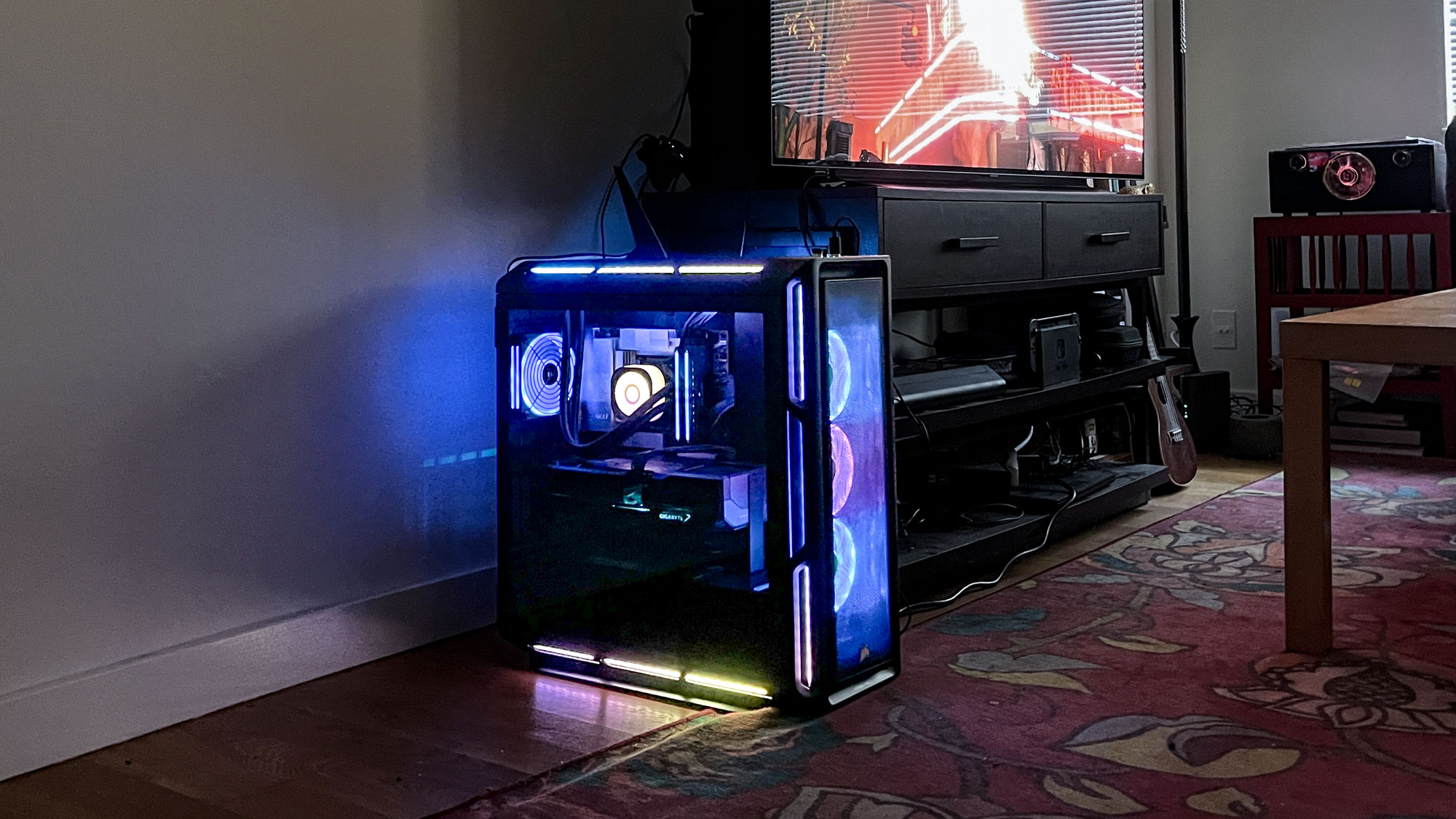
RGB LED light strips are practically de rigueur for gaming PCs these days, and while I loved them in the '90s these days I've grown tired of seeing my PC and peripherals lit up like cheap glowsticks.
But when I started playing around with the iCue software to control and customizing the 200+ RGB LEDs on the case of our Corsair Vengeance i8300 review unit, I was genuinely impressed. The RGB lighting on this machine stands out to me for two reasons: it has a more eye-catching LED strip layout than most PCs, and the customizable lighting patterns are more beautiful than anything I've seen on other PCs.
Obviously none of this matters as much as how capable, quiet and easy-to-access this PC is, but I wanted to also shout out the lighting because I love how the 5000T RGB case looks when the LED strips at bottom and top are running a smooth, shifting pattern. It sort of reminds me of how the engine rooms were lit up in Star Trek, and every time I look over at it I'm happy I have the lighting on — and it's been decades since I felt that way about a PC case.
Corsair Vengeance i8300 (2025) review: The downs
As much as I love our Corsair Vengeance i8300 review unit, I have to admit I have a quibble with (and one serious warning about) this premium 4K gaming PC.
Heavy and difficult to move
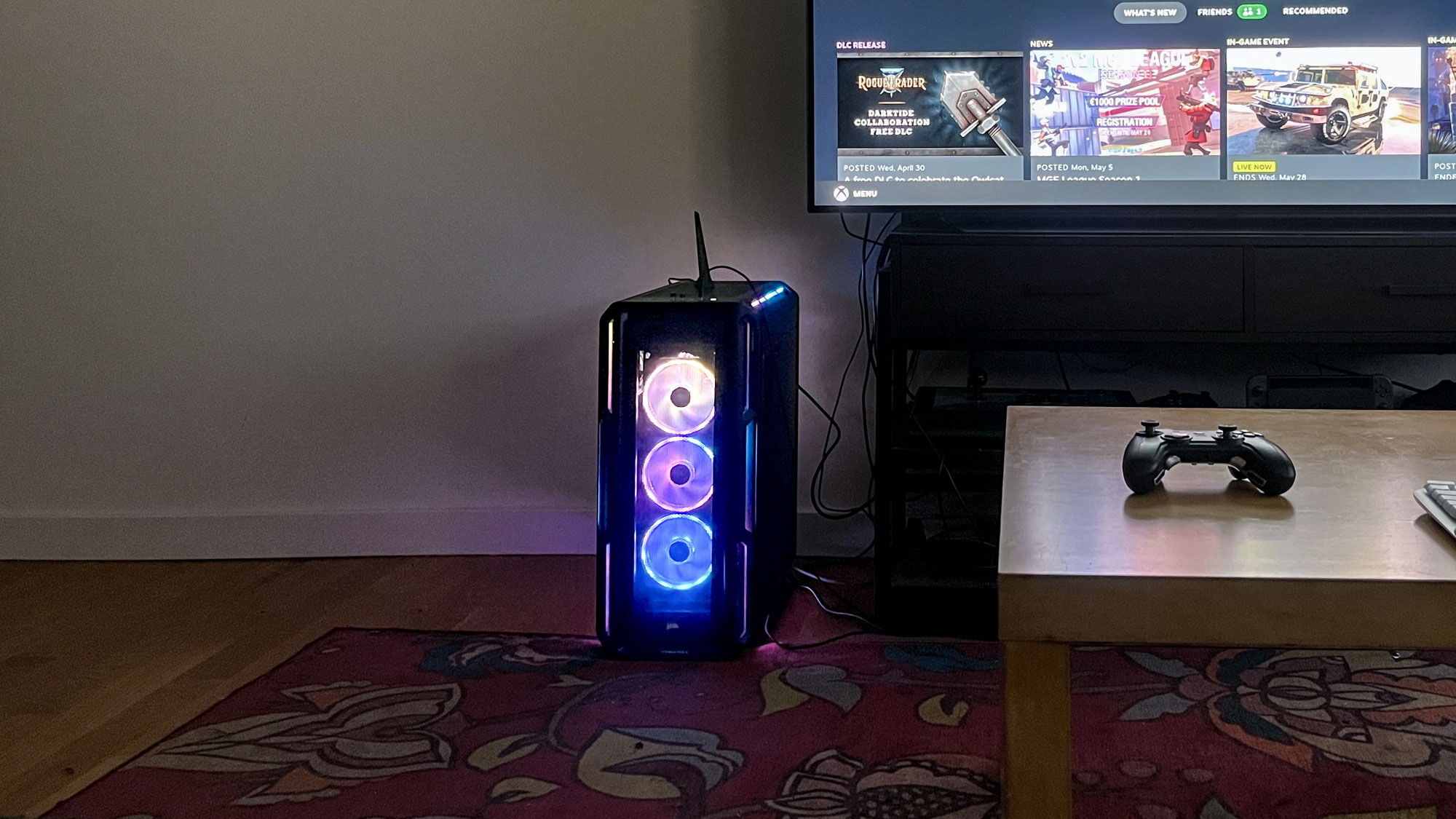
Let's get the quibble out of the way first: this beast is hefty and hard to move.
Partly that's because it weighs over 30 pounds, and partly it's because the case is roughly two feet tall.
The thing is heavy enough that I was scared to leave it on my Uplift V2 standing desk, because even though I'm pretty sure the desk could handle the burden, it wobbled in a concerning fashion every time I raised or lowered it with the Corsair onboard.
That said, once you get it set up you probably won't be moving it around as much as I did during the review process. So this is less a serious concern and more a warning: be ready to move a big, hefty box when this thing shows up.
Luckily, I will say that the process of unboxing the Corsair Vengeance i8300 was relatively straightforward, thanks to the company's streamlined bag-it-and-box-it approach.
Outperformed by cheaper gaming PCs in some games
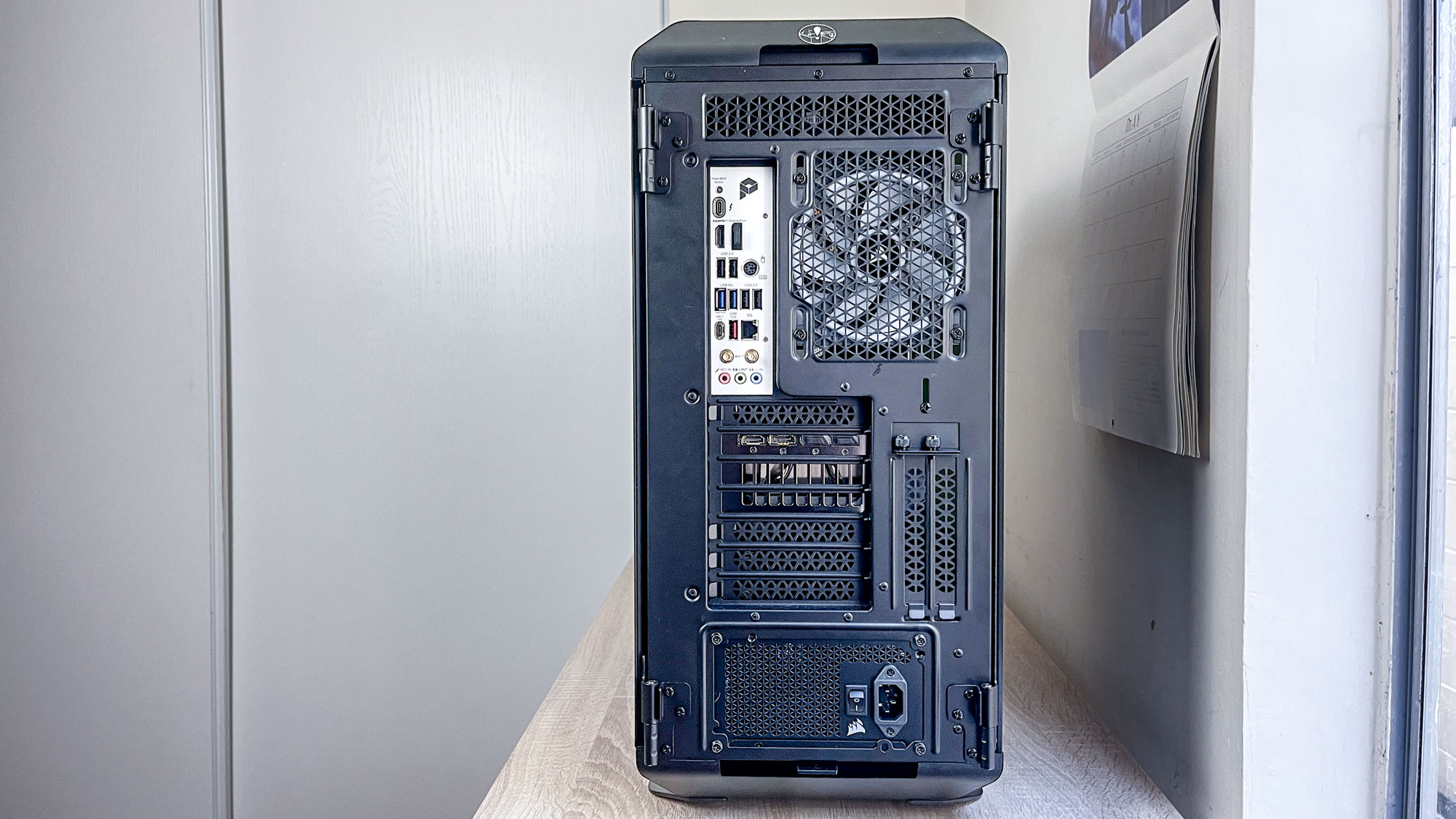
The most painful part of buying a Corsair Vengeance i8300 is its eye-watering price tag, so you expect to get best-in-class performance in return for spending over $7,000 on a PC.
And for the most part, you get it. As you can see from our test results, our Corsair Vengeance i8300 outperforms almost every other PC I've ever tested, including recently-released gaming PCs that cost thousands of dollars.
But as you also saw, the Alienware Area 51 costs almost $2,000 less than the Corsair Vengeance i8300 yet delivers equal or better performance in many games. And where it does fall behind the Corsair, it's only by a handful of frames, which probably isn't worth the premium you're paying for the Vengeance over the Area 51.
Now, FPS isn't the only thing that matters when buying a gaming PC. Despite its heft, the Corsair Vengeance i8300 is actually significantly lighter than the Alienware PC and comes with 3x the storage space (6TB vs. 2TB). So there are other benefits you're getting for that sky-high price.
But for most of us framerates and graphical performance are the #1 reason to invest in a gaming PC, and our testing reveals you can often get equal or better performance in those areas from the Area 51 for much less cash.
Corsair Vengeance i8300 (2025) review: Verdict

If you've read this far you can probably understand why I think our Corsair Vengeance i8300 review unit is one of the best gaming PCs of 2025, and one of the best ways to play PC games period.
I'll be sorry to ship it home after this review goes live, but it really has sparked a quiet revelation in how I think about gaming in the living room.
I've owned an Xbox Series X since launch and use it as my main gaming machine since it's quiet, quick to boot and runs games decently on my 4K TV. I know PCs are more capable gaming machines, but I've been leery to build a living room gaming PC because they can be so loud and unsightly.
The Corsair Vengeance i8300 is the exception that's given me pause, because despite its size it looks great lit up next to my TV and it runs games far better than my Xbox while remaining whisper-quiet the whole time. Obviously I can't afford a $7,000 gaming PC on a journalist's salary, but I'm seriously considering buying one of these Corsair iCue 500T RBG cases and building a cheaper gaming PC of my own inside.
So while I still think you get a better deal out of the Alienware Area 51 and would recommend it over the Corsair for those on a budget (not just a tight budget but any budget), I have to report that the Vengeance i8300 is the best gaming PC I've tested this year.

Alex Wawro is a lifelong tech and games enthusiast with more than a decade of experience covering both for outlets like Game Developer, Black Hat, and PC World magazine. A lifelong PC builder, he currently serves as a senior editor at Tom's Guide covering all things computing, from laptops and desktops to keyboards and mice.
You must confirm your public display name before commenting
Please logout and then login again, you will then be prompted to enter your display name.
